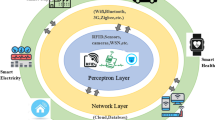Abstract
This study introduces a dynamic SDN-based port hopping routing (DSPHR) technique to enhance the practical security defense of software-defined wireless sensor networks (SD-WSNs) in wireless networks. DSPHR aims to thwart network probe and packet intersection attacks by formulating route hopping as a limitation resolution problem. The technique integrates the compliance quotient theory (CQT) solver to establish constraints for achieving multiple routes, addressing capacity and overlap constraints. The SDN controller of the WSN, following a route hopping strategy and designated hopping slots, configures flow entries in OpenFlow switches along each transmission route. These entries enable the proper forwarding of secured communication flows. Simultaneously, the information regarding ports and addresses undergoes random alterations, ensuring not only random route hopping but also concealing original communication entity details. Theoretical analysis and experimental simulations validate DSPHR’s efficacy, demonstrating seamless and optimal route hopping with minimal communication latency. The technique significantly bolsters practical security measures, providing robust defense against interception and probe attacks in SDN-based wireless networks.







Similar content being viewed by others
Data Availibility
The research dataset will be made available upon request.
References
Luo, Y.-B., Wang, B.-S., & Cai, G.-L. (2015). Analysis of port hopping for proactive cyber defense. International Journal of Security and Its Applications, 9, 123–134.
Luo, Y.-B., Wang, B.-S., Wang, X.-F., Zhang, B.-F., & Hu, W. (2017). Rpah: A moving target network defense mechanism naturally resists reconnaissances and attacks. IEICE Transactions on Information and Systems, 100, 496–510.
Shi, L., Jia, C., & Lu, S. (2007). Dos evading mechanism upon service hopping. In 2007 IFIP international conference on network and parallel computing workshops (NPC 2007), (pp. 119–122). IEEE.
Shi, L., Jia, C., & Lu, S. (2008). Full service hopping for proactive cyber-defense. In 2008 IEEE international conference on networking, sensing and control, (pp. 1337–1342). IEEE.
Shi, L., et al. (2017). A covert communication scheme based on DNA microdots for port hopping. International Journal of Performability Engineering, 13, 598.
Steingartner, W., Galinec, D., & Kozina, A. (2021). Threat defense: Cyber deception approach and education for resilience in hybrid threats model. Symmetry, 13, 597.
Jonke, Z., Habenschuss, S., & Maass, W. (2016). Solving constraint satisfaction problems with networks of spiking neurons. Frontiers in Neuroscience, 10, 118.
Luo, Y.-B. et al. (2015). Rpah: Random port and address hopping for thwarting internal and external adversaries. In 2015 IEEE Trustcom/BigDataSE/ISPA, (vol. 1, pp. 263–270).
Guo, X., & Na, X. (2011). A research of the port-hopping telecommunication techniques based on non-linear feedback shift register (nlfsr). In 2011 IEEE international conference on automation and logistics (ICAL), (pp 336–338).
Niu, Z., et al. (2020). Identification of critical nodes for enhanced network defense in manet-iot networks. IEEE Access, 8, 183571–183582.
Nunes, B. A. A., Mendonca, M., Nguyen, X.-N., Obraczka, K., & Turletti, T. (2014). A survey of software-defined networking: Past, present, and future of programmable networks. IEEE Communications Surveys & Tutorials, 16, 1617–1634.
Yan, J., Zhou, Y., Qin, G., Wang, T., & Bin, R. (2022). A hidden services port hopping approach for moving target defense. In ISCTT 2022; 7th international conference on information science, computer technology and transportation, (pp. 1–5).
Anajemba, J. H. et al. (2023). Sdn-based port hopping technique for mitigating network attacks. In 2023 International conference on software, telecommunications and computer networks (SoftCOM), (pp. 1–6). IEEE.
Zhang, Z., Ma, L., Poularakis, K., Leung, K. K. & Wu, L. (2019). Dq scheduler: Deep reinforcement learning based controller synchronization in distributed sdn. In ICC 2019-2019 IEEE international conference on communications (ICC), (pp. 1–7). IEEE.
Velasco, D. C., Rendon, O. M. C. & da Fonseca, N. L. S. (2023) Drsir: A deep reinforcement learning approach for routing in software-defined networking. Authorea Preprints.
Funding
Not applicable.
Author information
Authors and Affiliations
Corresponding author
Ethics declarations
Conflict of interest
The authors have not disclosed any competing interests.
Ethical Approval
Not applicable.
Additional information
Publisher's Note
Springer Nature remains neutral with regard to jurisdictional claims in published maps and institutional affiliations.
Rights and permissions
Springer Nature or its licensor (e.g. a society or other partner) holds exclusive rights to this article under a publishing agreement with the author(s) or other rightsholder(s); author self-archiving of the accepted manuscript version of this article is solely governed by the terms of such publishing agreement and applicable law.
About this article
Cite this article
Anajemba, J.H., Ababneh, N., Vajzovic, E. et al. DSPHR: A Dynamic SDN-Based Port Hopping Routing Technique for Mitigating SD-WSN Attacks. Wireless Pers Commun (2024). https://doi.org/10.1007/s11277-024-10979-7
Accepted:
Published:
DOI: https://doi.org/10.1007/s11277-024-10979-7




